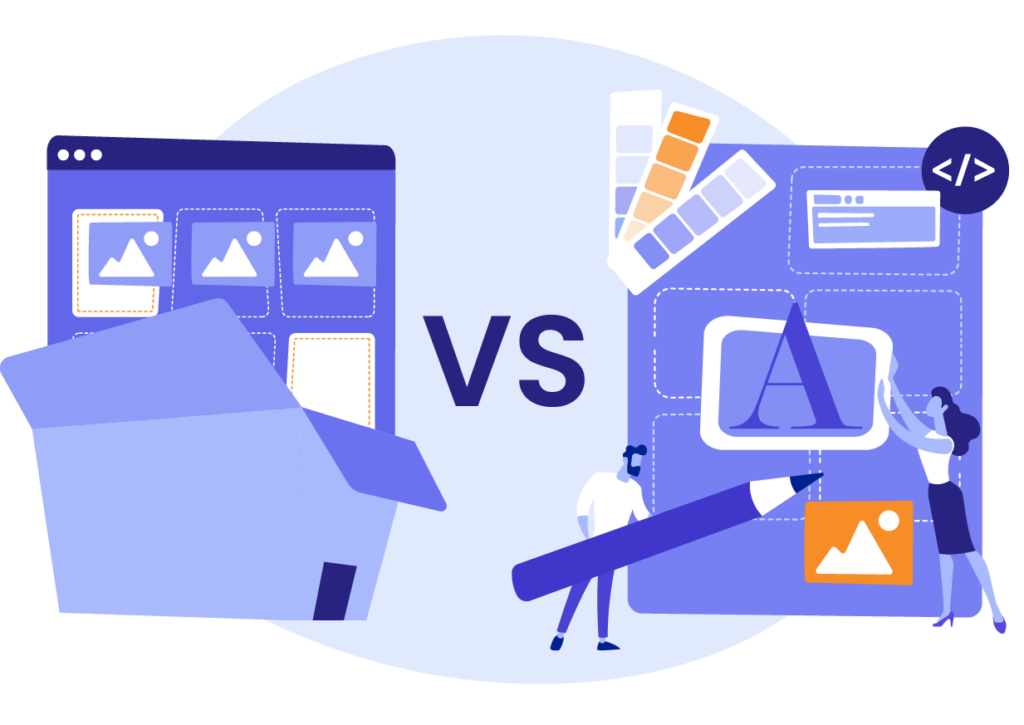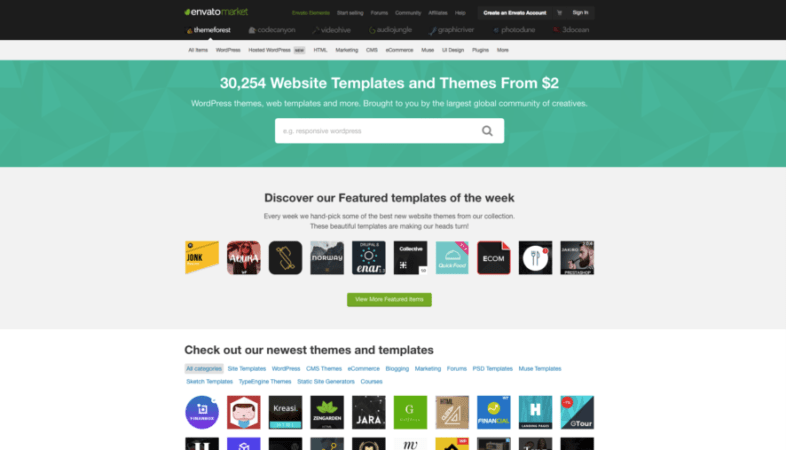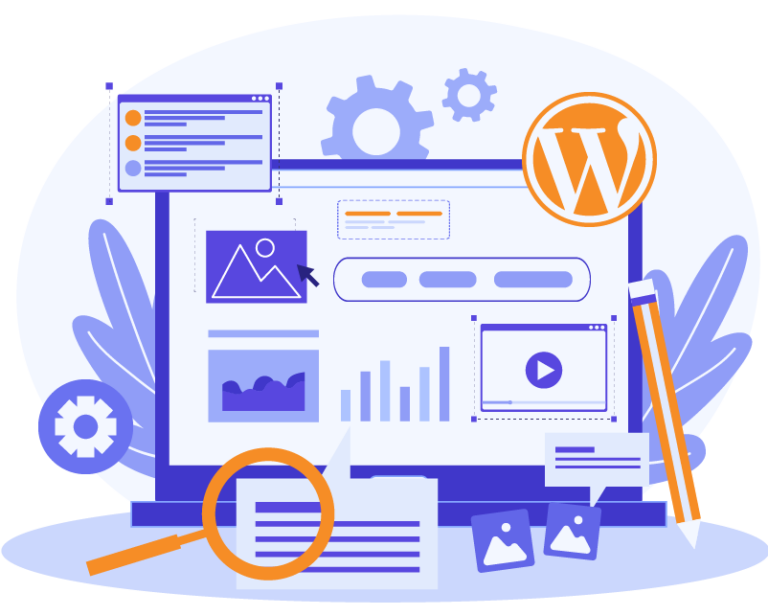With WordPress powering more than 25% of all sites on the Internet, it surely has a wide range of users. While you often hear about “free WordPress themes” and “build a website for free with WordPress”, most professional users still pay to get a better result. One option is to get a premium WordPress theme (paid theme), and another option is to develop a custom WordPress theme to your design files.
- Premium themes: Those willing to spend $50-100 on a premium theme can get better stability and more flexibility than what is offered by free themes.
- Custom themes: In terms of what WordPress can do – pre-built themes are only scratching the surface. Some of the most famous companies use WordPress to power their websites, but they’re using custom coded WordPress themes to achieve any design they want for their site.
But what’s really the difference between a site with a custom WordPress theme design and a site built on a premium theme? And how can you know which one to choose? That is what I answer in this article.
As a WordPress development company that helps digital agencies with PSD to WordPress conversions, we build approximately 1000 WordPress sites per year and thus have some experience to share on the topic.
Note: If you came here to learn how to build a custom WordPress theme yourself, here’s the guide you’re looking for: Converting HTML to WordPress: A Beginner’s Guide.
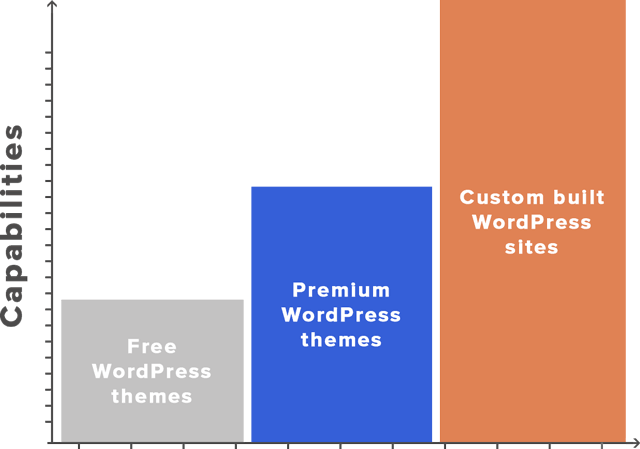
What is the Difference Between a Premium Theme and a Custom WordPress Theme?
The WordPress websites we build can be split into two types:
- What we call “PSD to WordPress”, which are custom built websites according to precise design specifications of our clients.
- Theme-based builds, where the websites are implemented according to a pre-set WordPress theme. Still using custom designs, but with a page builder installed.
Let’s start off with some basics so everyone can follow. All WordPress sites share a common core of code that visitors never see. This code is the “engine” and “skeleton” of the website, which allows administrators to log in, update and maintain the site.
Functionality such as image upload, commenting, adding pages, adding plugins, etc. are all found in the admin view. These are features that make WordPress much more user-friendly than building a website on pure HTML code.
What the visitors see is only the outer shell or “page templates”. These can be purely visual or include functionality such as forms, eCommerce, booking features etc. These parts can be built and customized from scratch (compare: plan your dinner, shop groceries and cook the meal), or they can be prepared in advance in a free or premium theme (compare: fill your plate from what’s offered at the lunch buffet).
What is a Premium Theme-Based WordPress site?
What’s commonly referred to as a “theme” is a prefabricated set of page templates that contain the visual elements of the site, most often integrated with plugins for certain functionality.
If you find a theme that looks like you want your site to look like, you can just download it and replace the images and content with your own and then you have your website up and running in no time.
These themes are built by WordPress developers, usually in companies specialized in building themes, with the business model of selling them in bulk to as many users as possible. ThemeForest and TemplateMonster are examples of sites where theme developers upload their themes for reselling, kind of like an “Amazon” or “App Store” for themes.
The themes have some flexibility built into them to make it easier to do configurations (and allow for a wider customer base), but this also comes with an additional code to allow for all possible combinations that users might do.
Some themes are like coloring books, and you can do only one thing and it makes it easy for you as long as that’s exactly how you want it done. Others are more like the Swiss army knife, and you’ll be carrying the whole thing even when all you need is a corkscrew. And there’s, of course, a spectrum in between, but you get the point.
We recently made an experiment to build the same site in two versions: custom made and on the popular Divi theme. The theme-based one had 13 times as many lines of CSS code!

The custom built one only had 1200 lines of CSS, compared to 16200 lines of CSS code for the Divi theme. In addition, the numerous options visible in the dashboard on a premium theme after the site is ready can also feel like a jungle to the WP Admin who wants to make minor adjustments later on.
What is a Custom WordPress Theme?
A custom WordPress site is in fact a “one-off theme”. A WordPress developer then creates the functionality and page templates according to the design files and specifications of one particular website.
These customized WordPress designs can mimic existing themes (like we did in our experiment), but they don’t have to. Instead, they can be completely unique to fully adapt to the style and intent of the designer and website owner – the same way a master chef can cook if they start from the base ingredients.
All its parts are integrated to work seamlessly together, and there are no “additional wires” that can cause shortcuts if something needs to be updated later on, making it more adaptable and flexible for those with development skills.

There are two myths about custom builds that we keep hearing:
The first one is that custom themes don’t update when WordPress brings some updates to security or bug fixing to the core. But this is the core and is not affected by the layers added on top of it with the custom page templates. Also, by sticking to the popular plugins, the risks of malfunction or hacker attacks is kept to a minimum.
The second myth is that a custom built site is more expensive than a theme based site. This can be true in some cases, so for companies with a very restricted budget, themes can be the best option. But over time it’s likely that the opposite is true, which we will dig deeper into in the next section.
When to Choose a Premium Theme and When to Choose a Custom WordPress Theme Instead
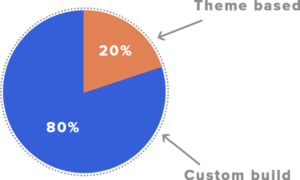
As a teaser, I can say that we never ourselves recommend a partner to go with a premium theme-based site for their client. However, about 20% of the sites we build are based on premium themes (never on free themes), so there are cases when marketing agencies and their clients decide that it’s the best way to go.
To illustrate the differences and when to choose one over the other, we’re bringing you three different cases of using premium themes: The good, the bad, and the ugly.
The Good Case of Using Premium WordPress Themes
An important factor when choosing between pre-made themes and custom builds lies in whether the web agency needs to create a unique design or not.
If the client is happy with their website looking like a particular theme, it can be a hard sell to convince them to spend money on designing something unique to their needs, which can instead be spent on more hours for content or SEO.
For instance, if you want a simple site and there’s a theme that looks and works just the way you want it, then you can probably shave off 8-16h of development time (e.g. 16h instead of 24h) by going with the theme. And you might even be able to do it yourself without much coding skills instead of having a developer do it, which is perhaps the main benefit that those choosing premium WordPress themes are seeking.
The time saved by using pre-made themes will be greater if there’s a feature such as an animation on the theme that already works just the way the customer wants it but would take us 8h to code ourselves. Note: even a small adjustment to the functionality can quickly eat up the time saved, but more on that later.
We usually get requests for theme-based sites from our smaller partners, that also have smaller customers who need to keep costs to a minimum. This is in general where it makes more sense to stay with the premium themes. If you think a theme-based WordPress site is for you, here are the most popular themes among our clients that you should consider:
#01 Divi
#02 X Theme
#03 Jupiter
#04 Salient
#05 Flatsome
#06 Bridge
The Bad Case of Using Premium WordPress Themes
So that was the good case of using a premium theme, and here’s when it gets tricky. If any changes are desired to the design or functionality of a theme, even small ones, we recommend these changes be incorporated into a PSD and submitted as a “PSD to WordPress” project as a custom build instead. This method is preferable to attempting to modify the code of the theme directly — in our experience that approach often has buggy results.
The exception is when the premium theme uses a page builder and the necessary change is permitted by the options of that page builder. Then it’s probably easier to change with the page builder. On the other hand, you can often accomplish enough flexibility with ACF Flexible Content when you’re using a custom theme.
As mentioned earlier, the premium themes have “additional wiring”, or software integrations, that allow you to create different configurations without much development skills. However, when you need a configuration that isn’t built into the theme already, the developer has to get into the jungle of theme code and hope that any modifications don’t break the code somewhere else and crash the site or introduce a hidden bug.
Let me give you a real example.
We built a site on a premium theme that worked well. Then our partner came back and asked us to tweak the functionality of its forms, based on a new request from their client.
Since the form plugin that was “wired” into the theme didn’t allow for this functionality, we had to spend 32h re-coding the theme to replace it with another plugin (Gravity Forms) that had this functionality. If it were one of our custom builds, the same request would probably have taken us 4-8h.
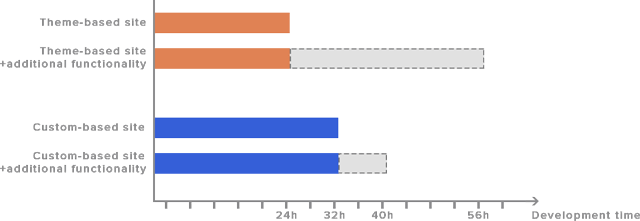
Two other factors that should make you think twice before choosing a theme-based site are quality and page loading speed. We always test our sites on validator.w3.org to make sure that the code doesn’t contain errors, and we’ve seen that when we test theme-based sites there are a bunch of those errors that we can’t really do much about.
Additionally, using prefabricated themes can drag down the page loading speed due to all the additional scripts and code that aren’t being used. Not only does that affect the user experience, but poor page loading speed will also be penalized by Google in the search rankings.
The Ugly Case of Using Premium WordPress Themes
Our Head of Production gets the shivers sometimes when the topic of theme-based sites comes up, and there are reasons for it.
Firstly, it happened more than once that partners (often the first time they come to us) want us to fix a broken site because:
- The premium or free theme is not supported with updates anymore, and when a plugin gets updated the site crashes.
- Someone had modified a theme to accommodate some special request, and now an update broke the site for this reason.
That was the first type of situation that can lead to severe headaches.
Secondly, when a partner brings us an existing site with a request for additional functionality it can take a lot longer. You saw this already as a “bad case”, but it can get worse. Some functionality takes more time to introduce to an existing theme than it takes to rebuild the whole site as a custom build. As you can understand, this is bad news for our partners:
They can ask: “We would like to implement X on this existing site”, to which we might reply: “Then we recommend rebuilding it from scratch”.
Rebuilding is often the best option in these cases, but due to the “fallacy of sunk costs”, some people prefer to spend 32h adding functionality to a theme that would take 24h to rebuild from scratch. The REALLY ugly case comes when they later bring another functionality request on top of that…. 🙁
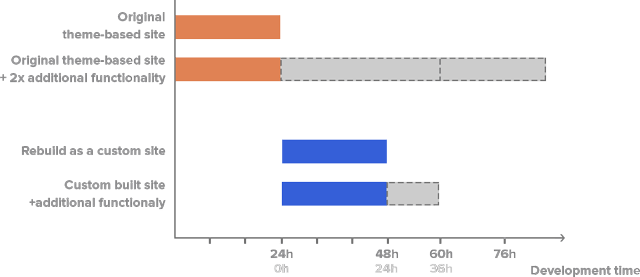
Conclusion

To sum up the comparison between a theme-based WordPress site and a custom built WordPress site, here are the main reasons for you to choose one over the other.
Go with a premium WordPress theme site if:
- You need a small website
- Have very limited budget
- Lack design and/or development skills (or inspiration)
- You found a theme that you’re excited about right out-of-the-box
- You don’t plan to make any functionality updates to it in the future
Go with a custom WordPress theme if:
- You feel that your site deserves a unique design to fit aesthetic or functional requests
- There’s no theme that fits your needs without modifications
- You believe you may want to update the site with new functionality at a later stage
- You want to be sure that the site is optimized for page loading speed and quality, and that any such issues can be easily resolved later on
- You want a lean admin dashboard, with just the options that you or your client will need to customize later on
